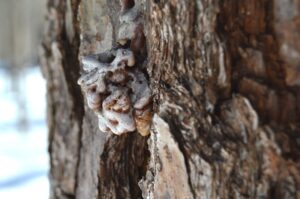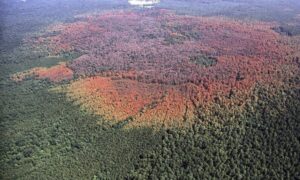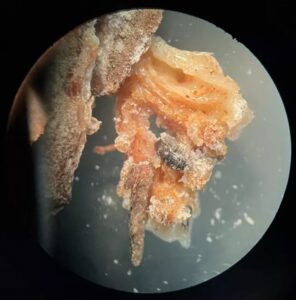The forests of the Outer Cape have undergone major changes throughout their history, affected by big forces, from fires to farming to 20th-century development. The next wave of change, however, is likely to come from an insect no larger than a grain of rice: the southern pine beetle.

Native to the southern U.S., these creatures are known for destroying large stands of pine trees. Their appetite for the trees’ bark is voracious. And thanks to climate change, they are spreading up the East Coast in the direction of the pines that dominate our forests.
“We’re on a long-term trajectory of it being a continuing problem here,” said Nicole Keleher, Forest Health Program director for the Mass. Dept. of Conservation & Recreation (DCR).
Southern pine beetles, according to Keleher, are much more aggressive than most bark beetles. They target relatively healthy pines, aggregate in huge numbers, and can quickly destroy a stand of trees.
When a female of the species arrives at a tree she wants to colonize, she will burrow into it and release a pheromone called frontalin. This chemical draws in thousands of other pine beetles, who burrow after her into the tree to access its nutrient-rich inner bark, according to an update on the species posted by the University of Florida Institute of Food and Agriculture.

Trees have their ways of fighting back, the Florida and Texas nematologists behind that report say. When a tree is infested, it will try to eject the beetles by filling their burrows with resin, in the process creating distinctive popcorn-like “pitch tubes” on the tree’s bark. It doesn’t always turn out to be an effective strategy though: nearby beetles recognize the scent of the resin as a sign of a tree in distress and are drawn to it, worsening the infestation. The beetles also sometimes carry a fungus with them that aids in the trees’ destruction.
If there are few enough beetles around, the trees’ defense mechanism can work. But once enough beetles have infested a tree, it cannot survive, and its needles turn orange as it withers away. The beetles will then lay their eggs in the tree, turning it into another epicenter of infestation once those eggs hatch.
Historically, Keleher said, southern pine beetles had a hard time surviving this far north. They don’t tolerate cold well, so our hard winter frosts tended to keep their populations in check. Later springs and earlier falls also gave them a narrower window in which to be active, limiting them to fewer generations each year.
Now, our summers are longer than ever, and our winters are less severe. While the average temperature has risen by only one degree since 1970, the coldest night each year is about seven degrees warmer than it was then, according to the nonprofit Climate Central. These warming trends have kept beetle populations higher in the winter and given them more time to spread each summer.
Researchers with the DCR started surveying for southern pine beetles in 2015 after a series of outbreaks on Long Island in 2014 caught experts by surprise. The beetles were found on Cape Cod that year, but in relatively low numbers.
Since then, however, the insect’s numbers have been increasing dramatically, and in 2023, the first outbreaks in Massachusetts occurred on Martha’s Vineyard and Nantucket, where whole stands of trees were infested. From above, the outbreaks look like fires: acres of yellow and orange expanding from within a sea of green pines.

On Long Island, where beetles were first noticed 10 years ago, their effects have been dramatic. Tens of thousands of trees have died, and the outbreaks show no signs of slowing down.
There’s no doubt that southern pine beetles are likely to show up in increasing numbers on the Outer Cape, said Stephen Smith, a plant ecologist at the Cape Cod National Seashore, especially because the beetles tend to thrive in “overstocked” pitch pine-dominant forests like the ones here. But how exactly these beetles will affect our forests is hard to predict, Smith said.
This past January, a dying tree at Pilgrim Heights in Truro was spotted by DCR entomologists with distinctive “popcorn” pitch tubes on its bark, Smith said. Upon inspection, it was clear that the tree had been infested with southern pine beetles, so DCR cut it down, then felled other trees to establish a buffer zone around the infestation. Smith said that this was the first pine beetle-infested tree that’s been identified here but added that Seashore scientists have no way of knowing if others have gone unnoticed.
Establishing buffer zones around infested trees seems to be the best way to control the insects’ spread. Keleher notes, however, that so far it seems these beetles behave strangely in the northeast. Instead of a group of southern pine beetles moving from one tree to the next in a straight line as they do in the south, beetles infesting northern pitch pines may jump a whole line of trees, or move in multiple directions at once, she said. Why they do this is not known.
Smith noted that, because of how unpredictable southern pine beetles are, managing them will first require studying how they behave on Cape Cod. “We’ll just have to monitor the best we can and formulate a plan as we see what’s happening,” he said.
One of the most unpredictable things about these beetles, according to Keleher, is that infestations sometimes vanish as quickly as they appear. In the south, their populations tend to explode, destroy entire stands of pines, then fizzle out. The trees in these areas sometimes later recover.
Smith said that the thinning the National Seashore has been doing for the last 15 years around the Marconi Wildlife Management Area in Wellfleet might help slow the beetles’ spread.
He also suggested the infestations could have an upside, helping to open up the forest. Cape Cod’s modern pitch-pine forests, he notes, are a historical anomaly, and the area was previously a patchwork of forest and open space that was maintained by both natural fires and land clearing. Smith thinks that beetles may help revive that mosaic. “I could be eating these words, but it may not be a catastrophe,” he said.
Keleher said that it’s important to manage infestations before they can spread. Her agency is asking people to report any trees with popcorn-like pitch tubes to the DCR. Even as the beetles become more common on the Cape, she believes there will almost certainly still be pitch pines here.
“They just might be a little bit different than we have it now,” she said.
